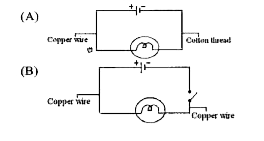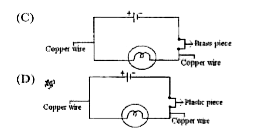Three incandecent bulbs of 100W each are connected in series in an electric circuit. In another circuit another set of three bulbs of the same wattage are connected in parallel to the same source.
(a) Will the bulbs in the two circuits glow with the same brightness ? Justify your answer.
(b) Now let one bulb in both the circuits get fused. Will the rest of the bulbs continue to glow in each circuit ? Give reason.
(a) Let us assume that the resistance of each bulb be R. The circuit diagram in two cases may be drawn as given below

Equivalent resistance in series combination R3=R+R+R=3R, voltage = V
Let current through each bulb in series combination be I1. By Ohm's law,
V=I1×3R⇒I1=V3R
So, power consumption of each bulb in series combination.
P1=I21(3R)=(V3R)2×3R=V29R2×3R
=V23R=V23R ....(i)
For parallel circuit, (1)
The resistance of each bulb = R
Voltage across each bulb = V [∵same voltage in parallel combination]
∴ Power consumption of each bulb in parallel combination.
P2=V2R ....(ii)
∵ From Eqs. (i) and (ii). we have P2P1=V2/RV2/3R
V2R×3RV2=3⇒P2=3P1
Therefore, each bulb in parallel combination glows 3 times brighter to that of each bulb in series combination.
(b) When one bulb fused in both the circuit, then in series combination, circuit gets broken and current stops flowing and remaining bulb don't glow. Whereas in parallel combination, same voltage continue to act on the remaining voltage and hence, other bulbs continue to glow with same brightness.
Topper's Solved these Questions
Similar Questions
Three incandescent bulbs of 100 W each are connected in series in an electrical circuit. In another circuit another set of three bulbs of the same wattage are connected in parallel to the same source.
(a) Will the bulb in the two circuits glow with the same brightness? Justify your answer.
(b) Now let one bulb in both the circuits get fused. Will the rest of the bulbs continue to glow in each circuit? Give reason.
View SolutionThree incandescent bulbs of 100W each are connected in series in an electric circuit. In another circuit, another set of three bulbs of the same wattage are connected in parallel to the same source.
(a) Will the bulbs in the two circuits glow with the same brightness ? Justify your answer.
(b) Now let one bulb in both circuits get fused. Will the rest of the bulbs continue to glow in each circuit ? Give reason.
(a) In a household electric circuits, different appliances are connected in parallel to one another. Give two reasons for the same.
(b) An electrican puts a fuse of rating 5A in that part of domestic electrical circuit in which electrical heater of rating 1.5kW,220V is operating. What iis likely to happen in this case and why ? What change, if any, needs to be made ?
View Solution
Knowledge Check
Two electric bulbs A and B are rated as 60 W and 100 W . They are connected in parallel to the same source. Then,
ABoth draw the same currentBA draws more current than BCB draws more current than ADCurrent drawn are in the ratio of their resistancesTwo electric bulbs A and B are rated as 60 W and 100 W . They are connected in parallel to the same source. Then,
AB draws more current than ABCurrent draws are in the ratio of their resistacesCBoth draw the same currentDA draws more current than B.Three electric bulbs of rating 60 W each are joined in series and then connected to electric mains. The power consumed by these three bulbs will be
A180 WB60 WC20 WD203W
Would the bulb glow in the circuit shown in figure ?

View SolutionBulb in this circuit doesn't glow, why?

View SolutionIn which case, bulb glows in the circuit.


View SolutionThree bulbs of 40, 60 and 100 watt are connected in series with the source of 200 volt. Then which of the bulb will be glowing the most –
View SolutionTwo electric bulbs AandB are rated 60and100W, respectively. If they are connected in parallel to the same source , then
View Solution
